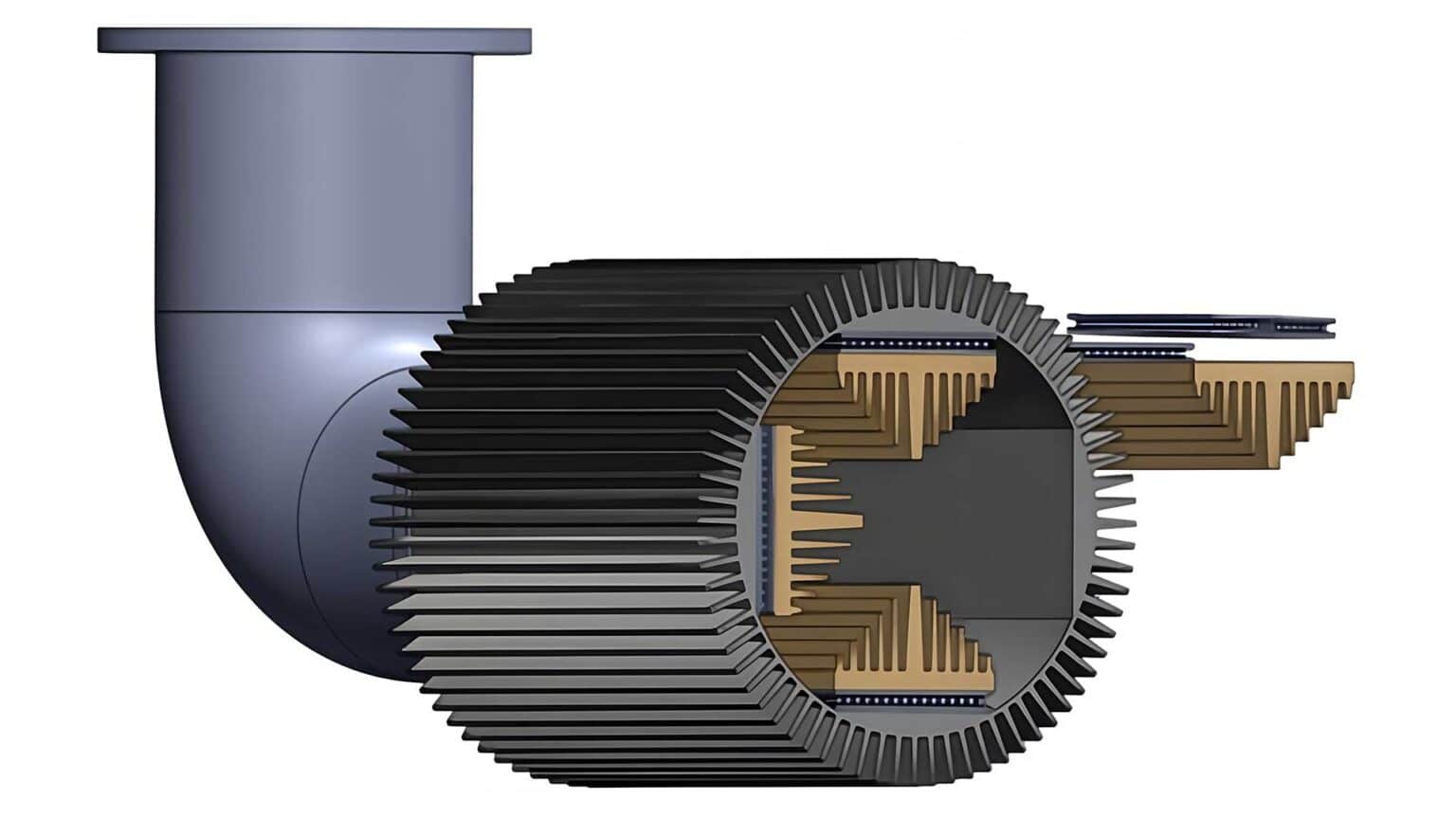The article opens with saying only 25% of the fuel’s energy gets used by the motor, 75% is in the heat of the exhaust. I’ll take that as a given. Let’s assume a small motor (in this inventions favour) with a nominal power of only 60 kW, running only at half tilt, 30 kW.
That gives us 90 kW in the exhaust heat by the numbers of the article. So the 56 W it captured in the simulation would be 0.046% of the total 120 kW power being converted by burning the fuel, raising the efficiency from 25% to 25.046%.
The headline is so massively overstated it’s basically just a lie. If the device was built, not just simulated, and you’d manage to substitute part of the alternator’s ouput with the thermoelectic generator’s output, the effect on fuel economy would be below the measurable level.

This device attaches to a car’s tailpipe, capturing heat and converting it into usable electricity. The researchers’ innovative system includes a semiconductor made of bismuth-telluride and uses heat exchangers—similar to those found in air conditioners—to capture heat from vehicle exhaust pipelines efficiently.
Basically, slap Peltier modules on the exhaust pipe. This ain’t gonna do much. We can invent a thousand applications for Peltier modules, until there is a massive technology breakthrough in terms of semi-condutor materials, it’s kinda pointless.
Reusing heat energy from exhaust is what turbos are doing for 120 years now.
I thought turbos converted air (exhaust) kinetic energy into mechanical energy, not the heat itself. If exhaust was cold, the turbo would still work, no?
Not saying that these Peltier devices are going to be game changers, but it sounds like they do something different from turbos in that they are capturing additional wasted energy.
Yes, and no. Heat and kinetic energy are fundamentally all just energy. What we call heat is, technically, the kinetic energy of molecules vibrating around.
When exhaust gas passes through a turbocharger, it is both slowed and reduced in pressure, resulting in it coming out slightly cooler than when it entered. This device is using a different method of getting energy out of the exhaust gas, but it’s fundamentally still the kinetic energy of those very energetic exhaust gas molecules bouncing against one side of the thermoelectric generator and giving up their energy into it. I would still expect the exhaust gas to come out of it slightly cooler and slower.
Your explanation about where the energy comes from with turbochargers sounds wrong to me.
When exhaust gas passes through a turbocharger,
You’re skipping a crucial step here. The exhaust gases get pushed through input of the exhaust gas impeller on the turbocharger by the movement of a piston in the engine during the exhaust cycle. This “work” isn’t free. Its energy that comes from the other pistons on their combustion cycle. If there is more resistance on the exhaust coming out of the engine (which there is to drive the turbocharger impeller), that energy must be added (robbed) by the energy at the crankshaft that ultimately powers the wheels.
The extra boost of power we experience in an engine from using a turbocharger is that the turbocharger allows more oxygen to be put into the combustion chambers (and the engine puts more fuel in at the same time). The extra energy is from burning - - more fuel in the same period of time than without turbocharging. The fuel is the source of the energy, the turbocharger isn’t recovering any energy.
The article is covering technology is actually recovering energy turning heat (thermal energy) back into electricity (electrical energy).
The exhaust gases get pushed
The “pushing” (exhaust stroke) isn’t particularly relevant.
When the valves close at the beginning of the compression stroke, the pressure in the cylinder is atmospheric: zero psig. The valves don’t open until the piston has risen (compression) and fallen (power) again. Without combustion, the pressure at the time the exhaust valves open is again at atmospheric. The gasses were compressed, and re-expanded, but only reach atmospheric. These gasses need to be pushed out.
With combustion, the pressure at the bottom of the stroke is substantially higher than atmospheric: the combustion event has radically increased the pressure of those gasses. At the end of the power stroke, just before the exhaust valves open, the pressure inside the cylinder is still extremely high. When the exhaust valves open, the overwhelming majority of the energy released to the exhaust stream is from the increased pressure. The “push” from the rising piston is relatively tiny.
It is the expansion of those gasses - not the “pushing” of those gasses - that drives the turbo.
I think it might be beneficial to think about the next evolution in aircraft propulsion. The turbocharger operates by expanding gasses through a power turbine, and using that energy to drive a compressor turbine. Remove the cylinders and pistons from the path, carefully tune those turbines, and you have a turbojet.
If the pistons are “pushing” the turbocharger, the turbojet would be impossible. It is the expansion of the gasses, not the displacement of the pistons, that drives the turbocharger.
The exhaust gases are at a high pressure after combustion due to combustion heat. The turbo does indeed increase exhaust pressure, and therefore extracts some work from the crank but it’s extracting significantly more from the high pressure of the expanded hot gas. It’s not “free” because it’s energy that is usually just wasted in a naturally aspirated engine. There are many examples of engine configurations where a turbo is used to boost efficiency by reducing displacement.
There were systems on old aircraft engines which used exhaust power recovery turbines geared directly to the crank. Those wouldn’t physically function under your concept.
The increase in manifold pressure doesn’t just increase oxygen in the cylinder. It also increases the manifold pressure, or the total mass of gases. The increase of oxygen does allow for more fuel and total energy in the ignition event but the extra
inertgas also expands when heated. So both play a factor in increasing mean effective pressure, and therefore energy output per cycle (power).Edit: im tired… Bad wording, adding inert gas to increase intake mass doesn’t help.
The turbo does indeed increase exhaust pressure, and therefore extracts some work from the crank but it’s extracting significantly more from the high pressure of the expanded hot gas.
I’ll admit I’m at the edge of my knowledge here, but are you saying that if we were increasing the pressure in the cylinder from, say pure nitrogen (or another inert), instead of atmosphere (which contains oxygen), and we kept the same amount of fuel from natural aspiration, we’re still get the majority of the benefit of turbocharging even overcoming the parasitic portion of extra energy needed during the compression cycle and the exhaust cycle against the turbocharger impeller?
even overcoming the parasitic portion of extra energy needed during the compression cycle and the exhaust cycle against the turbocharger impeller?
Let’s assume the contrary. Let’s assume it can’t. Let’s assume the turbocharger is a net drag on the engine, and any gains are only from enabling the engine to burn more fuel. If this is all true, then the turbocharger should not be able to function without the reciprocating engine. Without the “push” from the pistons during the exhaust stroke, the turbo shouldn’t be able to turn.
If we can show that the turbo can not only spin without the piston engine, but that additional energy can be harvested, we will have disproven this assumption.
So, let’s get rid of the pistons. Plumb the intake manifold directly to the exhaust manifold. We have one combined intake/exhaust manifold. We stick a couple spark plugs into that manifold and turn it into a combustion chamber.
Now we have air passing through a compressor turbine, into a combustion chamber and then through an exhaust turbine. Sound familiar?
Engineers discovered that some turbos were capable of producing more power than the engines they were attached to. They discovered that the reciprocating engine was a drag on the turbo. The only reason to keep the reciprocating engine was because material science hadn’t caught up. We didn’t have turbos capable of directly handling the heat of combustion.
That discovery gave us the jet engine.
Show this to any automotive engineer and count how many seconds before they start laughing
OMG they’ve actually introduced the 2025 Turboencapulator.
Not enough power to affect anything
Fools logic. This is a single system imagine the world running systems like this on every device or system, then the amount adds up. Energy recovery is the future. Maximizing what we can produce. Sustainability.
We already do this at every steam based power plant in the world (basically everything but hydro, PV, and wind) and it’s done much more efficiently. Doing this stuff with tiny gadgets on micro generators like ICE vehicles is a pretty inefficient implementation, especially as it adds weight to already heavy vehicles, decreasing efficiency and safety, and increasing tire and brake wear. The only place I can imagine this being useful is very heavy vehicles that for some reason still have to be using diesel like long haul trucks/busses, diesel freight trains etc and the like. And EVEN then you’re looking at major issues with economy. If you increase the weight of a truck by 2 percent to give it a 2% increase in fuel efficiency, you are hurting not helping. 2% comes off of your GCVWR margins and suddenly you need 51 trucks instead of 50 trucks to transport a given load, not only increasing your fuel use by 2% but also increasing vehicle maintenance and tire and brake pollution by 2%
Edit: I’m not saying relatively miniaturized energy recovery systems don’t have a future, but I’m dubious it’s in transport or handheld devices. At least for the foreseeable future. Infrastructure scale however has always been a major application for energy recovery development, stirling engine, steam turrbine and TE development keeps getting further pushed to eek efficiency out of power stations, power plants, substations, emergency generators, maybe even HVAC systems and other building scale applications.
In simulations mimicking high-speed environments, the waste-heat system demonstrated great versatility; their system produced up to 56 W for car-like exhaust speeds and 146 W for helicopter-like exhaust speeds, or the equivalent of five and 12 lithium-ion 18650 batteries, respectively.
A great step!
Next is build one.
Then cheap-ish and durable.
I doubt this will ever become any useful at all. 50 Watts is nothing compared to what the car engine outputs at high speed. Even a small engine has some 35kW, i.e. 35000 Watts.
I doubt regenerative braking will be ever useful at all because Lord knows you’re not going to get the same energy back that you took out while driving. /s
This is just to increase efficiency.
Sometimes efficiency gains aren’t worth the cost and complexity. Regenerative braking produces a shitton more power than this, so it’s worth it (also, the motors are already there, just run them in reverse and turn them into generators). You can get the same thing by slapping a solar panel on the roof. Which nobody is doing because it’s too costly and complex for what you get out of it.
This type of technology and the concepts of energy conservation and recovery are so damn cool. Think of drainage recovery systems for showers sinks and gutters, sewage, and on and on for various applications and types of recovery.







